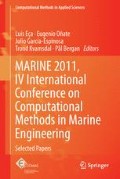Abstract
The objective of the present investigation is the numerical prediction of the potential of a flow to inflict surface damage by cavitation. For this purpose, physical criteria are derived that detect and quantify relevant flow phenomena. In particular, we present a numerical approach for tracing isolated collapses of vapor clouds during the numerical simulation of the flow. The suggested “collapse detector” provides the frequency of collapses, their positions, and resulting maximum pressures, as well as the maximum condensation rate of each event. This data, together with the maximum wall pressure, allow for an automatic indication of erosion-sensitive areas.
The employed flow solver CATUM (CAvitation Technische Universität München) is a density-based 3-D finite volume method equipped with a Low-Mach-number consistent flux function. All fluid components (liquid, vapor, saturated mixture) are modeled by closed form equations of state.
To assess this novel approach we simulate an experimentally investigated nozzle-target flow. A comparison of numerically predicted collapse events with the experimentally observed areas of cavitation erosion substantiates the proposed methodology. The obtained data represents a time-history of collapse events together with their position and strength, and may be used to estimate erosion rates.
Access this chapter
Tax calculation will be finalised at checkout
Purchases are for personal use only
References
Brennen CE (1995) Cavitation and bubble dynamics. Oxford University Press, New York
Franc J-P, Michel J-M (2004) Fundamentals of cavitation. Kluwer Academic, Dordrecht
Schnerr GH, Sezal IH, Schmidt SJ (2008) Numerical investigation of three-dimensional cloud cavitation with special emphasis on collapse induced shock dynamics. Phys Fluids 20(4):040703
Schmidt SJ, Thalhamer M, Schnerr GH (2009) Inertia controlled instability and small scale structures of sheet and cloud cavitation. In: Proc 7th CAV 2009—7th international symposium on cavitation, Ann Arbor, Michigan, USA, 16.8.–21.8.2009. Paper 17, CD-ROM publication
Schmidt SJ, Sezal IH, Schnerr GH, Thalhamer M (2008) Numerical analysis of shock dynamics for detection of erosion sensitive areas in complex 3-D flows. In: Proc WIMRC cavitation forum 2008, Warwick, UK, July 7–9, 2008, pp 107–120
Schmidt SJ, Mihatsch M, Thalhamer M, Egerer C, Hickel S, Adams NA (2011) Assessment of erosion sensitive areas via compressible simulation of unsteady cavitating flows. In: International workshop on advanced experimental and numerical techniques for cavitation erosion prediction, Grenoble, France, 1.3–2.3.2011. Post-workshop CD
Schmidt SJ, Mihatsch M, Thalhamer M, Adams NA (2011) Assessment of the prediction capability of a thermodynamic cavitation model for the collapse characteristics of a vapor-bubble cloud. In: Proc WIMRC cavitation forum 2011, Warwick, UK
Franc JP (2009) Incubation time and cavitation erosion rate of work-hardening materials. J Fluids Eng 131
Schmidt SJ, Mihatsch M, Thalhamer M, Adams NA (2013) Assessment of erosion sensitive areas via compressible simulation of unsteady cavitating flows. In: Chahine GL, Franc JP, Karimi A, Kim KH (eds) Advanced experimental and numerical techniques for cavitation erosion prediction. Springer, Berlin (in press)
Franc JP, Riondet M, Karimi A, Chahine GL (2012) Material and velocity effects on cavitation erosion pitting. In: Wear, pp 248–259
Franc JP, Riondet M, Karimi A, Chahine GL (2011) Impact load measurements in an erosive cavitating flow. J Fluids Eng 133
Karimi A, Leo WR (1987) Phenomenological model for cavitation erosion rate computation. Mater Sci Eng 95:1–14
Acknowledgements
We would like to thank Jean-Pierre Franc for providing detailed information on his experimental setup as well as for fruitful discussions and suggestions. All computational resources have been provided by the Leibniz Supercomputing Center.
Author information
Authors and Affiliations
Corresponding author
Editor information
Editors and Affiliations
Rights and permissions
Copyright information
© 2013 Springer Science+Business Media Dordrecht
About this chapter
Cite this chapter
Mihatsch, M.S., Schmidt, S.J., Thalhamer, M., Adams, N.A. (2013). Numerical Prediction of Erosive Collapse Events in Unsteady Compressible Cavitating Flows. In: Eça, L., Oñate, E., García-Espinosa, J., Kvamsdal, T., Bergan, P. (eds) MARINE 2011, IV International Conference on Computational Methods in Marine Engineering. Computational Methods in Applied Sciences, vol 29. Springer, Dordrecht. https://doi.org/10.1007/978-94-007-6143-8_11
Download citation
DOI: https://doi.org/10.1007/978-94-007-6143-8_11
Publisher Name: Springer, Dordrecht
Print ISBN: 978-94-007-6142-1
Online ISBN: 978-94-007-6143-8
eBook Packages: EngineeringEngineering (R0)

